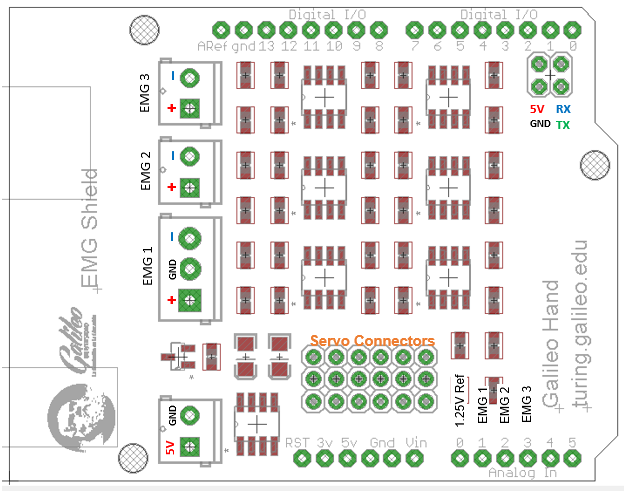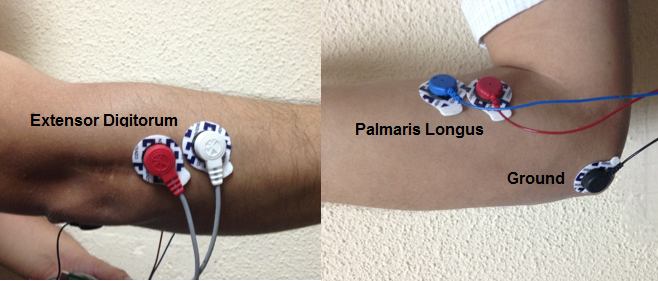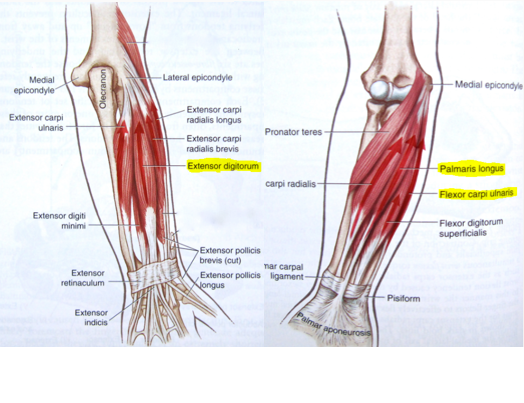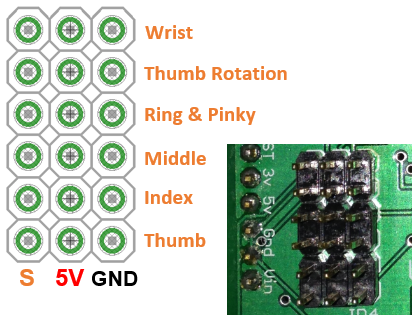This is a simple EMG Controller for a bionic hand prosthesis
Dependencies: mbed-dsp mbed NOKIA_5110
Galileo Bionic Hand - ST Nucleo Example

This is an example of a simple hybrid sEMG(surface Electromyography) activated controller for the Galileo Bionic Hand Prosthesis implemented with the Galileo EMG Shield. The user has to select the desired posture by sending a special character through serial port (115200 baud rate) and then perform it through sEMG activation by detecting contraction on flexor muscles of the forearm. Contractions on forearm extensor muscles releases the posture and allows the return to the default or rest posture.
Special characters:
- '1', for "Power Grip" selection
- '2', for "Point" selection
- '3', for "Pinch Grip" selection
- '4', for "Lateral Grip" selection
- '5' for "Tripod Grip" selection

Galileo EMG Shield - 3 Channels for surface EMG
The electrodes for sEMG are placed on the skin surface and are connected to the input of a precision instrumentation differential amplifier based on Texas Instruments (TI) INA122, then its output is passed through an active low pass filter (LPF) based on TI OPA335 in order to sense the action bio-potentials of the muscular fibers with an output signal span in the range of 0 to 3.3V and a bandwidth between 0 to 500 Hz. The circuit is built-in on a custom PCB with 3 sEMG channels and a bias voltage reference output (1.25 V); furthermore, it is pin compatible with Arduino pin compatible ARM Cortex M4 boards and mbed platform ecosystem (ST Nucleo F411RE, Freescale FRDM K64F, NXP LPCXpresso 4337, ST Discovery F746NG, Renesas GR-Peach, etc), which is ideal for the single ended input of a microcontroller in addition to contributing to low cost development kits.


Electrodes Placement and Connection
Standard surface mounted Ag/AgCl electrodes with wet conductive gels are placed on palmaris longus and extensor digitorum muscles (third channel could be placed on Flexor carpi Ulnaris), focusing only on below elbow disarticulation. These electrodes have been well-characterized and most of its properties are well understood, except for some properties as drifting and low-frequency noise. Nevertheless, with proper preparation of the skin, the sEMG signal is excellent.
Disposable electrodes and snap leads information:
- http://bio-medical.com/products/din-ekgemgeeg-snap-leads-24-inch.html
- http://bio-medical.com/products/covidien-kendall-disposable-surface-emg-ecg-ekg-electrodes-1-24mm-50pkg.html
Proper placement of disposable electrodes for two channels of surface EMG is shown below:


Customizable Postures
You can customize the actions by modifying PWM values (microseconds) on FingerPosition function (values depends on the way that the hand was built it). The prosthesis has five fingers and a thumb rotation mechanism and five actuators in order to perform multiple types of grasping. Wrist rotation will be implement later.
The servo motors have to be connected as shown below:

Function Declaration and Usage Examples
include the mbed library with this snippet
void FingerPosition(float32_t thumb_us, float32_t index_us, float32_t middle_us, float32_t pinky_us, float32_t thumbrot_us); FingerPosition(2400, 600, 600,2400,2400); //Close FingerPosition(2400,2400, 600,2400,2400); //Point FingerPosition(2400, 600,2400, 600,2400); //Pinch FingerPosition(2400, 600, 600,2400, 600); //Lateral FingerPosition(2400, 600, 600, 600,2400); //Tripod FingerPosition(1000,2400,2400, 600, 600); //Open
Serial Oscilloscope Feature
This feature easily allows to watch and log to file the data using serial oscilloscope software (115200 baud rate).
- Serial_Osciloscope(TRUE,RAW) to watch raw signals, FALSE deactivate this feature
- Serial_Osciloscope(TRUE,RECTIFIED) to watch rectified signals, FALSE deactivate this feature
- Serial_Osciloscope(TRUE,SMOOTH) to watch smooth signals, FALSE deactivate this feature

Universal Real-Time Software Oscilloscope GUI information: http://www.oscilloscope-lib.com/
Nolia 5110 LCD
Nokia 5110 display implementation for visual feedback will be add later, we have to modify libraries and fonts in order to improve the functionality. The main idea is to change of action by pressing a push button and change thresholds using a potentiometer.

Information
Videos, bill of materials and tutorials to build the Galileo EMG Shield and the Galileo Bionic Hand will be posted soon, more information on:
- turing.galileo.edu/index.php/projects/galileo-hand
- http://bit.ly/arm_bionic_robo_hand
- http://bit.ly/galileo_hand_article
Diff: main.cpp
- Revision:
- 5:49c5553b6e2c
- Parent:
- 4:d8fd3c4484cc
- Child:
- 6:78494092a326
diff -r d8fd3c4484cc -r 49c5553b6e2c main.cpp
--- a/main.cpp Wed Sep 30 22:50:24 2015 +0000
+++ b/main.cpp Sun Oct 11 03:42:30 2015 +0000
@@ -1,9 +1,14 @@
#include "mbed.h"
#include "arm_math.h"
-#define FLEXION 0.2f
-#define EXTENSION 0.2f
-#define FLEXION2 0.00f
+#define TRUE 1
+#define FALSE 0
+#define RAW 0
+#define RECTIFIED 1
+#define SMOOTH 2
+#define THRESHOLDF 0.25f
+#define THRESHOLDE 0.25f
+#define FLEXION2 0.0f
Ticker EMG_Sampler;
Serial pc(SERIAL_TX, SERIAL_RX);
@@ -18,6 +23,7 @@
PwmOut Pinky(D6);
PwmOut ThumbRot(D5);
+//EMG samples and DSP variables
float32_t EMG1, EMG2, EMG3;
float32_t samples[25];
float32_t samples2[25];
@@ -25,57 +31,60 @@
float32_t abs_output[25];
float32_t abs_output2[25];
float32_t abs_output3[25];
-float32_t mean = 0.0f, mean2 = 0.0f, mean3 = 0.0f;
+float32_t mean = 0.0f;
+float32_t mean2 = 0.0f;
+float32_t mean3 = 0.0f;
+
+//variables for state machines
uint8_t state = 0;
+uint8_t action = 0;
+
+//conversion and data collection complete flag
uint8_t COCO = 0;
+//functions declaration
+void PWM_Init(void);
void ADC_Sampler(void);
-void Close(void);
-void Open(void);
-
+void RX_Interrupt(void);
+void Serial_Oscilloscope(uint8_t activation, uint8_t type);
+void FingerPosition(float32_t thumb_us, float32_t index_us, float32_t middle_us, float32_t pinky_us, float32_t thumbrot_us);
int main() {
pc.baud(115200); //Serial com at 115200 bauds
+ pc.attach(&RX_Interrupt); //Serial RX interrupt attachment
EMG_Sampler.attach(&ADC_Sampler, 0.001); //1 ms ticker for ADC Sampler
- //Open -> 0.6ms - Close 2.4ms
- Thumb.period(0.02f/2.0f);
- Thumb.pulsewidth(0.0010f/2.0f);
- //Open -> 2.4ms - Close 0.6ms
- Index.period(0.02f*2.0f);
- Index.pulsewidth(0.0024f*2.0f);
- //Open -> 2.4ms - Close 0.6ms
- Middle.period(0.02f*2.0f);
- Middle.pulsewidth(0.0024f*2.0f);
- //Open -> 0.6ms - Close 2.4ms
- Pinky.period(0.02f*2.0f);
- Pinky.pulsewidth(0.0006f*2.0f);
- //Open -> 0.6ms - Close 2.4ms
- //ThumbRot.period(0.02f/2.0f);
- ThumbRot.pulsewidth(0.0006f*2.0f);
+ PWM_Init(); //Servo initialization
+ myled = 1;
- myled = 1;
while(1) {
if(COCO){
- arm_abs_f32(samples, abs_output, 25); //rectifier
- arm_abs_f32(samples2, abs_output2, 25); //rectifier
- arm_abs_f32(samples3, abs_output3, 25); //rectifier
- arm_mean_f32(abs_output, 25, &mean); //mean
- arm_mean_f32(abs_output2, 25, &mean2); //mean
- arm_mean_f32(abs_output3, 25, &mean3); //mean
- //pc.printf("%.10f,%.10f\n\r",mean,mean2);
+ arm_abs_f32(samples, abs_output, 25); //rectifier EMG1
+ arm_abs_f32(samples2, abs_output2, 25); //rectifier EMG2
+ arm_abs_f32(samples3, abs_output3, 25); //rectifier EMG3
+ arm_mean_f32(abs_output, 25, &mean); //mean EMG1
+ arm_mean_f32(abs_output2, 25, &mean2); //mean EMG2
+ arm_mean_f32(abs_output3, 25, &mean3); //mean EMG3
+ Serial_Oscilloscope(FALSE,SMOOTH);
switch(state){
case 0: {
- if (mean>FLEXION){
+ if (mean>THRESHOLDF){
myled = 0;
state = 1;
- Close();
+ switch(action){
+ case '1': FingerPosition(2400, 600, 600,2400,2400); break; //Close
+ case '2': FingerPosition(2400,2400, 600,2400,2400); break; //Point
+ case '3': FingerPosition(2400, 600,2400, 600,2400); break; //Pinch
+ case '4': FingerPosition(2400, 600, 600,2400, 600); break; //Lateral
+ case '5': FingerPosition(2400, 600, 600, 600,2400); break; //Tripod
+ default: FingerPosition(2400, 600, 600,2400,2400); //Close
+ }
}
} break;
case 1: {
- if (mean2>EXTENSION){
+ if (mean2>THRESHOLDE){
myled = 1;
state = 0;
- Open();
+ FingerPosition(1000,2400,2400, 600, 600); //Open
}
}
}
@@ -84,12 +93,12 @@
}
}
+//EMG sampler Ts = 1ms
void ADC_Sampler() {
EMG1 = (E1.read()-Ref.read())*3.3f;
EMG2 = (E2.read()-Ref.read())*3.3f;
EMG3 = (E3.read()-Ref.read())*3.3f;
- //pc.printf("%.10f,%.10f,%.10f\n\r",EMG1,EMG2,EMG3);
- //pc.printf("%.10f,%.10f\n\r",EMG1,EMG2);
+ Serial_Oscilloscope(TRUE,RAW);
uint32_t m = __get_PRIMASK();
__disable_irq();
for(int j=24;j>0;j--) {
@@ -104,18 +113,54 @@
COCO = 1;
}
-void Close(void){
- Thumb.pulsewidth(0.0024f/2.0f);
- Index.pulsewidth(0.0006f*2.0f);
- Middle.pulsewidth(0.0006f*2.0f);
- Pinky.pulsewidth(0.0024f*2.0f);
- ThumbRot.pulsewidth(0.0024f*2.0f);
+//action selection trough serial console
+void RX_Interrupt(void){
+ action = pc.getc();
+ /*switch(action){
+ case '1': pc.printf("Power Grip\n"); break;
+ case '2': pc.printf("Point\n"); break;
+ case '3': pc.printf("Pinch\n"); break;
+ case '4': pc.printf("Lateral\n"); break;
+ case '5': pc.printf("Tripod\n"); break;
+ default: pc.printf("Power Grip\n");
+ }*/
}
-void Open(void){
+//PWM initialization for servos
+void PWM_Init(void){
+ //Open -> 0.6ms - Close 2.4ms
+ Thumb.period(0.02f/2.0f);
Thumb.pulsewidth(0.0010f/2.0f);
+ //Open -> 2.4ms - Close 0.6ms
+ Index.period(0.02f*2.0f);
Index.pulsewidth(0.0024f*2.0f);
+ //Open -> 2.4ms - Close 0.6ms
+ Middle.period(0.02f*2.0f);
Middle.pulsewidth(0.0024f*2.0f);
+ //Open -> 0.6ms - Close 2.4ms
+ Pinky.period(0.02f*2.0f);
Pinky.pulsewidth(0.0006f*2.0f);
- ThumbRot.pulsewidth(0.0006f*2.0f);
-}
\ No newline at end of file
+ //Open -> 0.6ms - Close 2.4ms
+ ThumbRot.pulsewidth(0.0006f*2.0f);
+}
+
+//send data through serail port for oscilloscope visualization
+void Serial_Oscilloscope(uint8_t activation, uint8_t type){
+ if (activation){
+ switch(type){
+ case RAW: pc.printf("%.10f,%.10f,%.10f\n\r",EMG1,EMG2,EMG3); break;
+ case RECTIFIED: pc.printf("%.10f,%.10f,%.10f\n\r",abs_output[0],abs_output2[0],abs_output3[0]);break;
+ case SMOOTH: pc.printf("%.10f,%.10f\n\r",mean,mean2,mean3); break;
+ default: pc.printf("%.10f,%.10f,%.10f\n\r",EMG1,EMG2,EMG3);
+ }
+ }
+}
+
+//finger position through servos - values on microseconds (600 us - 2400 us)
+void FingerPosition(float32_t thumb_us, float32_t index_us, float32_t middle_us, float32_t pinky_us, float32_t thumbrot_us){
+ Thumb.pulsewidth(thumb_us/1000000.0f/2.0f);
+ Index.pulsewidth(index_us/1000000.0f*2.0f);
+ Middle.pulsewidth(middle_us/1000000.0f*2.0f);
+ Pinky.pulsewidth(pinky_us/1000000.0f*2.0f);
+ ThumbRot.pulsewidth(thumbrot_us/1000000.0f*2.0f);
+}
 Julio Fajardo
Julio Fajardo